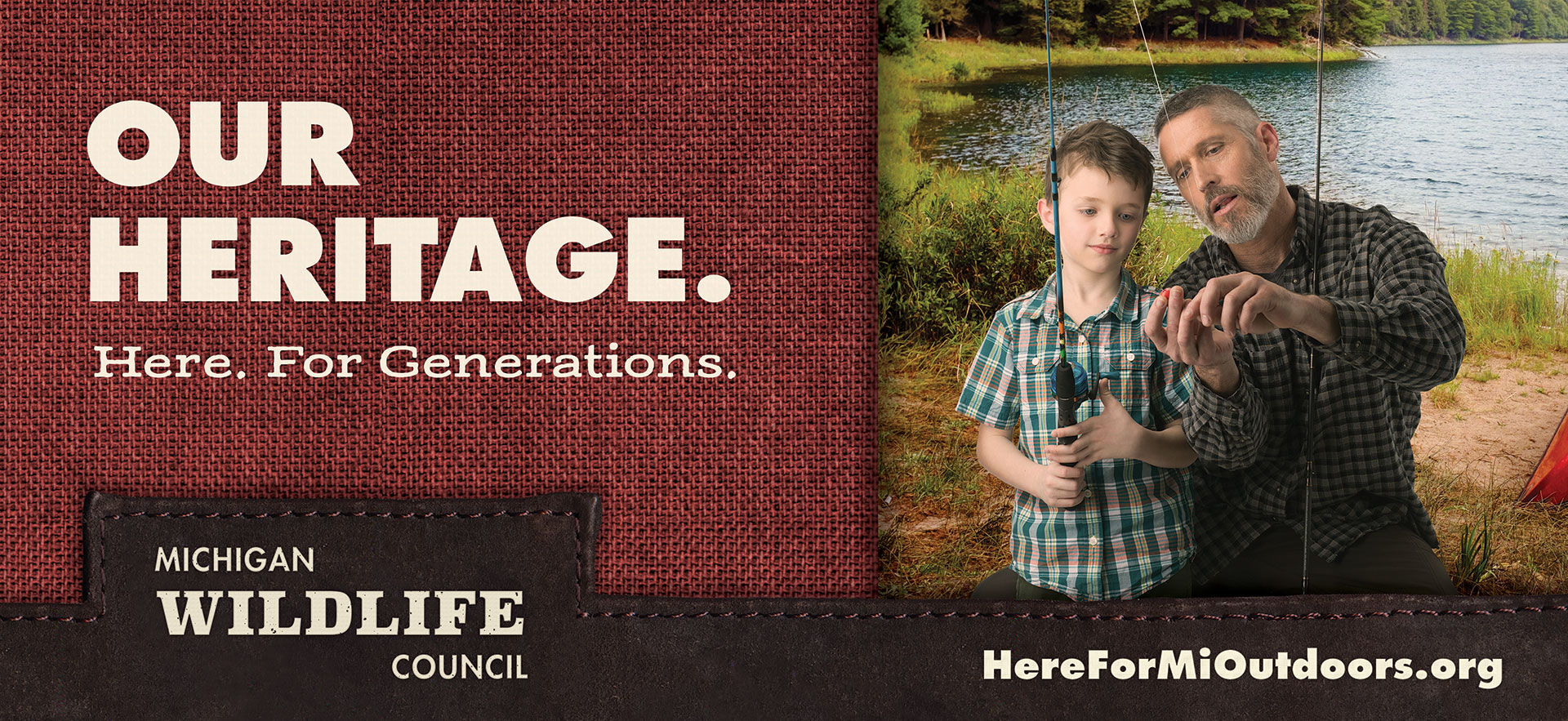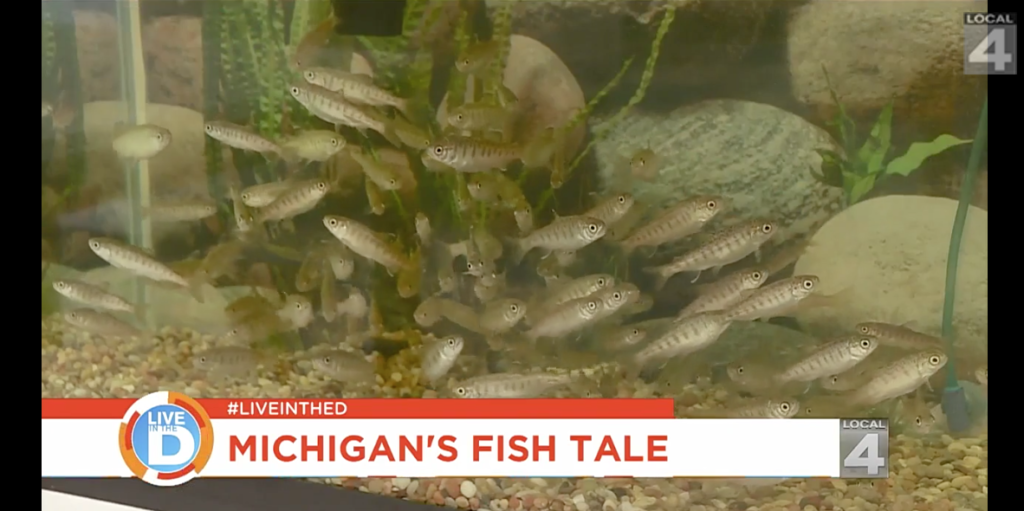Aim of Michigan Wildlife Council’s innovative five-year awareness push is to preserve state’s outdoor heritage for future generations
April 14, 2016
Media Contact: Mike Nowlin 989-450-0855
LANSING – The state of Michigan and its Michigan Wildlife Council (MWC) today announced the kickoff of “Here. For Generations.” – the state’s first-ever campaign to promote awareness of the importance of wildlife conservation in Michigan.
“Many Michigan residents have the impression that our wildlife and natural environment manages itself or that it’s simply an ‘Up North’ issue that does not impact them or their community,” Carol Rose, former chair of the nine-member MWC, said during a press conference this morning at the state Capitol.
“The more they know how wildlife conservation benefits activities they love – such as camping, canoeing, hiking, swimming or bird-watching – they will better appreciate that scientific management of our natural resources is essential to preserving Michigan’s great outdoors for future generations,” Rose said.
A statewide MWC-commissioned survey that was conducted July 24–31, 2015, to measure public opinion, understanding and level of engagement regarding the state’s wildlife management activities shows that:
- Across Michigan, 90 percent of the population believes it is important to keep wildlife healthy and free of disease.
- At least 88 percent of the state’s citizens agree it’s important to protect Michigan’s wildlife species from becoming endangered or extinct.
- However, 61 percent of Michiganders either do not believe or are unsure that wildlife requires management by humans to survive and thrive.
- Most people in Michigan are unaware that the majority of wildlife conservation activities are funded by revenue from the sale of hunting and fishing licenses – 91 percent of the state’s residents either don’t know or mistakenly believe that wildlife management is funded with state taxpayer dollars.
- The lack of understanding is particularly prevalent in West Michigan, where approximately 36 percent of the region’s population say they are uncertain whether wildlife requires human management to survive.
- Similarly, in Southeast Michigan, approximately 40 percent of the region’s citizens say they are either neutral about or not interested in wildlife.
The survey included a sample of 800 people with a margin of error of plus or minus 3.5 percent.
“The future of Michigan’s wildlife and ecosystems can’t depend solely on our conservation programs,” said state Rep. Andrea LaFontaine, R-Columbus Township, who chairs the House Natural Resources Committee.
“It depends on individuals understanding and taking action to protect Michigan’s wildlife and their habitats,” LaFontaine added.
As state Sen. Dave Hildenbrand, R-Lowell, noted, “Understanding is the first step toward helping to preserve wildlife and embracing conservation. That’s why growing public awareness is necessary.”
“The MWC’s education campaign will provide people with knowledge, information and skills about the importance of conservation and wildlife management,” said state Rep. Fred Durhal III, D-Detroit. “The goal is to help all of our state’s citizens become educated about wildlife and Michigan’s natural resources.”
The MWC is a public body established by Public Act 246 of 2013. Members are appointed by the governor and subject to the advice and consent of the Senate. The nonpartisan all-volunteer panel was created by the Legislature to direct the expenditures of the Michigan Wildlife Management Public Education Fund, which is dedicated to informing the state’s residents about the beneficial aspects of wildlife conservation and management.
Michigan’s 2016 launch of its inaugural “Here. For Generations.” campaign represents the start of a five-year statewide education effort that features television ads – which can be viewed at the MWC’s YouTube channel – complemented by a website (http://HereForMiOutdoors.org), billboards, radio, social and digital ads.
A new license fee structure the Michigan Legislature established in 2014 requires the state Department of Natural Resources (DNR) to use $1 from the sale of every hunting and fishing license to fund the MWC campaign. The $1 share of each license sale generates approximately $1.6 million annually in revenue that is geared toward promoting awareness and education about Michigan’s wildlife and outdoor heritage.
Wildlife management strives for a balance that benefits public, private and wildlife interests, according to state Rep. Winnie Brinks, D-Grand Rapids.
“This important work helps to create a heritage that instills within individuals a personal connection to Michigan and its natural beauty,” Brinks said. “The research, analysis and field work conducted by Michigan’s wildlife managers is key to maintaining and improving the state’s habitats that allow wildlife to survive and thrive.”
The future of Michigan’s tourism industry, for example, is tied to nurturing the state’s world-class wildlife assets and extensive, high-quality natural resource base, added Brinks, who serves on the House Tourism and Outdoor Recreation Committee.
“The survival of our state’s wildlife relies on the preservation of their habitats,” said Brinks. “Michigan’s wildlife managers are vital to protecting our natural environments, public health, scenery, recreation tourism opportunities and our economy.”
To ensure that the wildlife populating Michigan’s waters and lands continue to thrive, Michigan uses scientifically based conservation and management methods, Rose said. And while wildlife management is a complex process, the ultimate aim is to protect, maintain or restore wildlife populations, spur sustainable recreation use and enjoyment, and support natural resource–based economies.
Michigan’s conservation managers are responsible for a wide variety of activities, with examples ranging from stocking baby walleye and preserving their habitats near Beaver Island or protecting endangered ospreys from near extinction in southeast Michigan’s Huron Valley to measuring the impacts of climate change on West Michigan fisheries, overseeing construction of new pump stations that help manage wetlands along the Saginaw Bay, monitoring the health of deer herds in the northern Lower Peninsula and harvesting trees in the Upper Peninsula.
Ranking fourth in numbers nationwide, the Great Lakes State’s nearly 2 million hunters and anglers spend approximately $5 billion annually and support almost 73,000 jobs, data from the U.S. Fish and Wildlife Service shows. Wildlife watching contributes another $1.2 billion to Michigan’s economy, the agency reports.




